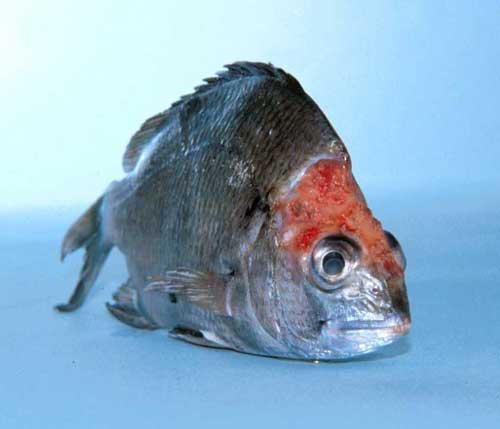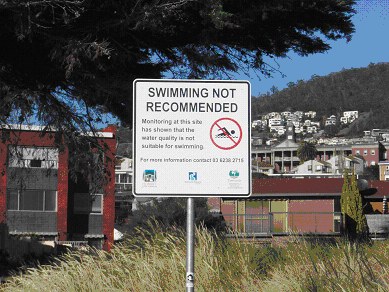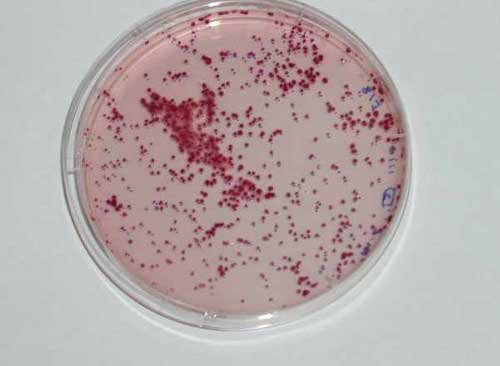What are pathogens?
The origin of the word pathogen is Greek: “pathos” means disease; and “genos” means birth. Therefore a pathogen is a causative agent of disease. Microbial pathogens are microscopic organisms. They include bacteria, viruses, protozoa and fungi. Marine pathogens may affect humans or marine organisms. Pathogens present a hazard to humans recreating in infected waters or beach sands when an infective dose colonises a suitable growth site in the body and leads to disease. Sites of infection are the alimentary canal, ears, eyes, nasal cavity, skin and upper respiratory tract1. Some exposure pathways include head or face immersion, swallowing water (including splashed water during boating), entering water up to or beyond waist level and skin abrasions1. Consumption of contaminated shellfish also exposes humans to marine pathogens.
Faecal streptococci/enterococci are the recommended indicator for human pathogens in marine waters and gastrointestinal symptoms are a frequent health outcome associated with exposure1. Other illnesses and conditions caused by contact with pathogen-contaminated waters include skin rashes, typhoid fever, acute febrile respiratory illness (AFRI)2, salmonellosis, meningo-encephalitis, cryptosporidiosis and giardiasis3. An example of a pathogenic disease affecting fish assemblages is epizootic ulcerative syndrome. Low-pH increases the susceptibility of fish to this fungal disease (photo 1).

Photo 1. Exposure to acid water and toxic heavy metals associated with disturbed acid sulfate soils damages fish skin and gills, increasing the susceptibility of fish to fungal infections such as Epizooitic Ulcerative Syndrome (EUS; also known as ‘red-spot’ disease). EUS results in red ulcerative lesions on fish, leaving them unsaleable and it may result in fish death (photo reproduced with permission of ‘QASSIT, Qld Department of Natural Resources and Mines’).
Sources of marine pathogens
Some pathogens occur naturally in marine waters. Others are carried into waterways after defecation/urination/shedding from human or animal hosts (e.g. via sewage effluent, agriculture and stormwater runoff, sewage from ships, recreational population using the water, industrial processes, wildlife, septic tanks near the shore and urban development)1. Rivers discharging into coastal areas may carry abundant micro-organisms from these diverse sources. High concentrations of pathogens usually occur after storms due to surface runoff, sediment re-suspension and because rainwater gets into sewerage pipes through faults and illegal connections and causes sewage to overflow. Contamination from human sources (e.g. faecal pollution) presents a greater risk to humans than contamination from animal sources because many animal pathogens are not infectious to humans. Risks to humans from pathogenic organisms are higher in areas with large population densities or with a significant tourism, and are perhaps best assessed by the volume of stormwater and coastal discharges indicators.
Waterways susceptible to pathogens
Waterways with a high pathogen risk to humans include areas with high bather densities, or areas where riverine discharge carries sewage effluent (photo 2). When sewage is relatively warm and of low salinity compared to receiving water, it may form a slick which moves rapidly into recreational areas1. Onshore winds, coastal currents and tides may also increase the pathogen risk in coastal waters and beach sands when sewage is discharged through long sea-outfalls. However most of the outbreaks associated with microbial pathogens occur in small, shallow bodies of water frequented by children, and investigations have shown that the children were the main etiological agent (i.e. carriers)45. Sheltered coastal areas such as closed bays – characterised by small volumes, low circulation and low water exchange rates – attract recreational water users. These small bodies of water behave similarly to swimming pools and should be managed as such.
Suspended sediments can provide food, shelter and transport for microbes6. Therefore, water column turbidity can promote waterborne disease outbreaks, and the bottom sediment can act as a reservoir for some pathogens (e.g. viruses7 ). Dredging or boating activity can cause sediment re-suspension and the release of viruses stored in sediment7. Electrostatic forces that bind viruses to sediment can be overcome by hydrological changes to an estuary that influence water column pH, salinity or particulate organic matter content (e.g. changes in freshwater flow).

Photo 2. Closure at Nutgrove Beach, Tasmania, due to pathogenic organisms (photo supplied courtesy of DEP, Tasmania).
Persistence of pathogens in the marine environment
Naturally occurring, free-living pathogens (e.g. some strains of Vibrio and Pseudomonas) can survive indefinitely. Other pathogens (e.g. from faecal contamination sources) have limited survival periods outside host animals/humans. Therefore, some impacts may be acute or seasonal. Sediment acts as a reservoir for viruses7. Factors that influence persistence of pathogens include: water temperature, UV/sunlight, dispersion and dilution, and salinity7.
Significance of marine pathogens
Unsafe densities of pathogens in coastal waters can lead to restrictions on shellfish harvesting, fish kills and if ignored or unnoticed, to health problems in humans and other organisms. Swimming or recreating in pathogen-contaminated waters most frequently leads to gastroenteritis. Economic losses incurred by pathogens include closure of shellfish fisheries and the costs associated with medical treatment and lost time at work.
Considerations for monitoring, assessment and management
It is not possible to routinely measure all viruses, parasites and dangerous bacteria in seawater. Therefore, faecal indicator bacteria are used as ‘indicators’ (e.g. faecal/thermotolerant coliforms, E. coli, enterococci/faecal streptococci). The presence of these organisms in high numbers indicates contamination by faecal material from warm-blooded animals (including humans). For marine waters, only faecal streptococci (or enterococci) show a dose-response relationship for both gastrointestinal illness8 and AFRI9. Faecal streptococci (photo 3) are therefore recommended as the faecal indicator for monitoring marine water quality for recreational use1. Different pathogen-indicator organism relationships may exist between saline and fresh waters, so the same level of faecal indicator bacteria in freshwater and marine environments does not mean the health risk is the same10.
Faecal indicator bacterial densities should be assessed according to national guidelines (ANZECC 1992; reproduced in ANZECC and ARMCANZ 200011 ). Detection methods are standardised: AS4276.8 for the estimation of the most probable number or AS 4276.9 for the membrane filtration method1213. For waterways susceptible to faecal contamination, an annual sanitary inspection should be conducted on our samples collected on five occasions during the bathing season10.
A new approach recommended by the World Health Organisation (WHO) includes conducting a sanitary assessment of recreational water catchments (including interviews and site visits to determine all contamination sources) and use of the enterococci group as bacterial indicators. This is a two-component approach to assessing risk of illness from recreational bathing. It is expected that Australia will adopt the WHO approach. Guidelines for conducting sanitary assessments in Australia using the WHO approach have been completed by the Water Services Association of Australia. The WSAA guidelines will be considered for inclusion into guidelines presently being developed by the National Health and Medical Research Council (NHMRC).
If monitoring of recreational waters and assessment of a catchment shows the location to be unsuitable, contaminant sources should be identified and the contamination reduced. Signs should also be posted advising of health risks and beaches may be closed. Mismatches between catchment-linked faecal sources and recreational water indicator densities also leads to a management response, such as further investigation to identify the reason.

Photo 3. (faecal streptococci bacteria, photo provided by Dr M. Lepesteur).
Existing information and data
Predicting transport of viruses in coastal waterways in some cases requires an understanding of processes that govern the transport and deposition of sediment7. Conceptual models depicting sediment transport in different coastal waterway types (e.g. tide-dominated deltas, tide-dominated estuaries, tidal creeks, wave-dominated deltas, wave-dominated estuaries, strand plains/coastal lagoons, and embayments 14 ) are available in the OzEstuaries database.
More information on bacteria/pathogens.
Data deficiencies
Epidemiological data that link indicator densities to burden of disease are missing in the Australian context15. Compliance data that link indicator levels to pathogen densities under Australian water conditions are also missing.
Author
Dr Muriel Lepesteur, School for Environmental Science, Murdoch University
Contributors
Graham Rooney, Melbourne Water
- WHO, 2001a. Guidelines for safe recreational-water environments. Volume 1: Coastal and fresh waters. ↩ ↩ ↩ ↩ ↩ ↩
- Fleisher, J.M., Kay, Salmon, R.L., Jones, F., Wyer, M.D., and Godfree, A.F., 1996a. Marine waters contaminated with domestic sewage: nonenteric illnesses associated with bather exposure in the United Kingdom. American Journal of Public Health, 86(9):1228-1234. ↩
- Prüss, A., 1998. A review of epidemiological studies from exposure to recreational water. International Journal of Epidemiology, 27:1-9. ↩
- Barwick, R.S., Levy, D.A., Craun, G.F., Beach, M.J., and Calderon, R.L., 2000. Surveillance for waterborne-disease outbreaks-United States, 1997-1998. Morbidity and mortality weekly report, 49:1-37. ↩
- Kramer, M.H., Sorhage, F.E., Goldstein, S.T., Dalley, E., Wahlquist, S.P., and Herwaldt, B.L., 1998. First reported outbreak in the United States associated with a recreational lake. Clinical infectious disease, 26:27-33. ↩
- EPA Guidance Manual – Turbidity Provisions. ↩
- Miller, B.M. Issues for the modelling of fate and transport of viruses in estuarine environments, 15th Australasian Coastal and Ocean Engineering Conference, September 2001, Gold Coast. ↩ ↩ ↩ ↩ ↩
- Kay, D., Fleisher, J.M., Salmon, R.L., Wyer, M.D., Godfree, A.F., Zelenauch-Jacquotte, Z., and Shore, R., 1994. Predicting likelihood of gastroenteritis from sea bathing; results from randomized exposure. Lancet, 344(8927):905-909. ↩
- Fleisher, J.M., Kay, D., Wyer, M., and Merrett, H., 1996b. The enterovirus test in the assessment of recreational water-associated gastroenteritis. Water Research, 30:2341-2346. ↩
- WHO, 2001b. Bathing water quality and human health, Outcome of an expert consultation, Farnham, UK, April 2001. ↩ ↩
- ANZECC/ARMCANZ (October 2000) Australian Guidelines for Fresh and Marine Water Quality. ↩
- Standards Australia, 1995a. Method 8: Faecal streptococci-Estimation of most probable number (MPN). AS4276.8. ↩
- Standards Australia, 1995b. Method 9: Faecal streptococci-Membrane filtration method. AS4276.9. ↩
- Heap, A., Bryce, S., Ryan, D., Radke, L., Smith, C., Smith, R., Harris, P. and D. Heggie. 2001. https://data.gov.au/dataset/australian-estuaries-and-coastal-waterways-a-geoscience-perspective-for-improved-and-integrated. AGSO Record 2001/07, pp. 118. ↩
- Lepesteur, M., Pond, D., Wegner, A., McComb, A., Ho, G.E., and Moore, S., 2002. Health risk and water quality impact assessment of recreational activities in the Peel Harvey Estuary. In: Proceedings of “Tropical Temperate Transition”, Australian Marine Science Association Conference, Fremantle July 10-12, 2002, Australia. ↩


